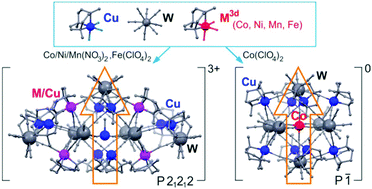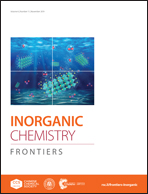A heterotrimetallic synthetic approach in versatile functionalization of nanosized {MxCu13–xW7}3+ and {M1Cu8W6} (M = Co, Ni, Mn, Fe) metal–cyanide magnetic clusters†
Abstract
Heterotrimetallic twenty-metal-centred {[MIIxCuII13–x(Me3tacn)12(H2O)][WIV(CN)8]2[WV(CN)8]5}·[WV(CN)8]·n(solvent) (M = Co, x = 1, 1; M = Ni, x = 1.5, 2; M = Mn, x = 1.5, 3; M = Fe, x = 1.5, 4; solvent = MeOH, H2O) and fifteen-metal-centred {CoII[CuII(Me3tacn)]8[WV(CN)8]6}·18MeOH (5) metal–cyanide clusters have been synthesized and characterized. They were obtained by the combination of Cu(II) complexes of 1,4,7-trimethyl-1,4,7-triazacyclonane (Me3tacn) with octacyanidotungstate(V) ions with the addition of other transition metal ions. Using nitrates of Co(II), Ni(II) and Mn(II), or a perchlorate of Fe(II), twenty-metal-centred 1–4 were generated while the application of Co(II) perchlorate gave fifteen-metal centred 5. 1–4 exhibit an open-winged cage topology with octahedral sites partially occupied by non-copper 3d metal centers while five-coordinated sites are occupied only by Cu(II). In 5, Co(II) occupies the centre of a six-capped body-centred cube topology while Cu(II) remains at the external sites. The added transition metal ions enhance the stability of W(V), partially hampering the reduction to W(IV) in 1–4 when compared with the bimetallic {Cu13W7} analogue. It also enables a straightforward synthesis of 5 involving only W(V) without the electrochemical stabilization of this oxidation state. As a result, 1–5 exhibit enhanced magnetic properties when compared with their Cu–W analogues. The addition of Co, Ni, Mn and Fe into the {Cu13W7} clusters produces also the (+3) charge of trimetallic molecules, and breaks the molecular and crystal symmetry, which is reflected by the crystallization of a chiral cluster core with [WV(CN)8]3– counterions in the chiral P21212 space group. Our work shows efficient control over the nuclearity, charge, chirality and magnetism of metal–cyanide clusters achieved by anion-assisted incorporation of various 3d metal ions into the CuII(Me3tacn)[W(CN)8]n− system.



 Please wait while we load your content...
Please wait while we load your content...